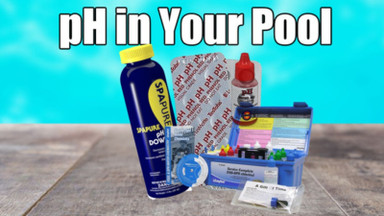Published by EZ Pool & Spa Supply on 05/15/2017
The Importance of pH in Your Pool
In one of our recent blogs on pool chemistry we discussed the role of chemicals in general, the ranges to shoot for, and the reasons for maintaining those ranges. In this week’s blog I’d like to address pH specifically (and pH’s close relative Total Alkalinity) and the many good reasons for maintaining these levels. So what are pH and total alkalinity and why are they so important? What are the effects of maintaining and, as well as not maintaining, these levels?
The importance and roles of pH and alkalinity are often not well understood even by veteran pool owners. pH is simply the measure of how acidic or basic the water is. Think back to high school science class (if you can remember!) and you may remember a numbered scale from 0 to 14, with 7 being perfectly neutral, 0 being extremely acidic and 14 being extremely basic – see picture. The desired range for pH is 7.2-7.6 (incidentally very close to the pH of the human body). Alkalinity, or more accurately total alkalinity is a measure in parts per million (ppm) of how much alkaline substance is in the water. Total alkalinity is closely related (what I like to call a “sister component”) to pH. Total alkalinity functions to stabilize, or buffer, the pH and prevent pH bounce. Since most pools are open to the elements pH bounce can occur as things enter the pool in large quantities – anything from rain, leaves, heavy swimmer load, shocking the pool, etc. The desired range for total alkalinity is 80-120 ppm for plaster pools, and 100-150 ppm for vinyl or fiberglass pools – we’ll discuss the reason for this difference in another blog.
So what if your pH is off? More than you might think, especially if it is way off and has been for some time. The pH scale is logarithmic, which means that a pH of 6.7 is 5 times more acidic than 7.2 reading. A reading of 6.2 is 10 times more acidic than a 7.2, and so on.
Low pH has many damaging effects. For one it is irritating to the human body with symptoms of itchy skin, red eyes, and hair becoming more brittle. It hits you in the pocketbook as well, since low pH greatly lowers effectiveness of chlorine – so money you are spending on chlorine is being wasted due to limiting its power. Also all metal accessories and hardware in contact with the water are subject to corrosion from the acidic nature of the water. This is particularly an issue for heaters, where copper from the heat exchanger is often stripped completely out due to low pH in a very short amount of time. When this happens you’re in for a very large bill that did not have to happen so prematurely. Plaster in gunite pools can erode from low pH too – another very costly repair expense!
On the flip side, high pH has its problems. High scaling, or mineral deposits occur due to the fact that many minerals come out of solution as pH rises. Cloudy water that will not clear up is more likely to happen on the high side. Irritation to skin and eyes may occur as well on the plus side of the scale. Remember the human body is very close to neutral on the scale.
Total alkalinity as we mentioned, is not the same as pH but closely related, effecting the pH’s stability. Low alkalinity often goes hand in hand with low pH and/or allows pH bounce – the undesirable rapid change in pH. High total alkalinity similarly will work to keep pH high and not allow for it to be adjusted easily.
As you may see now there is a lot more to pH than just numbers on a scale and dumping in of chemicals trying to hit the numbers just right. There are true benefits to maintaining these levels – some in the short and some in the long run. It’s a “pay now or pay later” situation.





